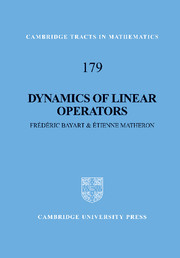Book contents
- Frontmatter
- Contents
- Introduction
- 1 Hypercyclic and supercyclic operators
- 2 Hypercyclicity everywhere
- 3 Connectedness and hypercyclicity
- 4 Weakly mixing operators
- 5 Ergodic theory and linear dynamics
- 6 Beyond hypercyclicity
- 7 Common hypercyclic vectors
- 8 Hypercyclic subspaces
- 9 Supercyclicity and the Angle Criterion
- 10 Linear dynamics and the weak topology
- 11 Universality of the Riemann zeta function
- 12 An introduction to Read-type operators
- Appendices
- References
- Notation
- Author index
- Subject index
4 - Weakly mixing operators
Published online by Cambridge University Press: 10 December 2009
- Frontmatter
- Contents
- Introduction
- 1 Hypercyclic and supercyclic operators
- 2 Hypercyclicity everywhere
- 3 Connectedness and hypercyclicity
- 4 Weakly mixing operators
- 5 Ergodic theory and linear dynamics
- 6 Beyond hypercyclicity
- 7 Common hypercyclic vectors
- 8 Hypercyclic subspaces
- 9 Supercyclicity and the Angle Criterion
- 10 Linear dynamics and the weak topology
- 11 Universality of the Riemann zeta function
- 12 An introduction to Read-type operators
- Appendices
- References
- Notation
- Author index
- Subject index
Summary
Introduction
In Chapter 3, we saw that hypercyclicity is a rather “rigid” property: if T is hypercyclic then so is Tp for any positive integer p and so is ⋋T for any ⋋ ∈ T. In the same spirit, it is natural to ask whether T ⊕ T remains hypercyclic. In topological dynamics, this property is quite well known.
DEFINITION Let X be a topological space. A continuous map T : X → X is said to be (topologically) weakly mixing if T × T is topologically transitive on X × X.
Here, T×T : X×X → X×X is the map defined by (T×T)(x, y) = (T(x), T(y)). When T is a linear operator, we identify T×T with the operator T⊕T ∈ L(X⊕X). We note that, by Birkhoff's transitivity theorem 1.2 and the remarks following it, one can replace “topologically transitive” by “hypercyclic” in the above definition if the underlying topological space X is a second-countable Baire space with no isolated points. In particular, a linear operator T on a separable F-space is weakly mixing iff T ⊕ T is hypercyclic.
By definition, weakly mixing maps are topologically transitive. In the topological setting, it is easy to see that the converse is not true: for example, any irrational rotation of the circle T is topologically transitive but such a rotation is never weakly mixing. In the linear setting, things become very interesting because weak mixing turns out to be equivalent to the Hypercyclicity Criterion.
- Type
- Chapter
- Information
- Dynamics of Linear Operators , pp. 75 - 94Publisher: Cambridge University PressPrint publication year: 2009



